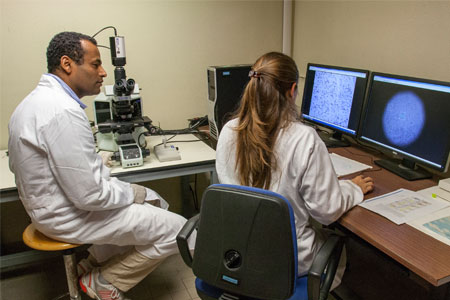- Autori:
-
Vanoli, Alessandro; Piva, Nestor; Inzani, Frediano Socrate; Grillo, Federica; Klersy, Catherine; Uccella, Silvia; Spaggiari, Paola; Albarello, Luca; Schiavo Lena, Marco; Milione, Massimo; Antoniacomi, Caterina; Milanetto, Anna Caterina; Zerbi, Alessandro; Di Sabatino, Antonio; Falconi, Massimo; Anderloni, Andrea; Mattiolo, Paola; Luchini, Claudio; Scarpa, Aldo; Fassan, Matteo; Parente, Paola; Luinetti, Ombretta; Rindi, Guido; Paulli, Marco; La Rosa, Stefano
- Titolo:
-
Clinicopathological Correlates of Hormone Expression-Based Subtypes of Non-Functioning Duodenal/Ampullary Neuroendocrine Tumors: A Multicenter Study of 151 Cases
- Anno:
-
2025
- Tipologia prodotto:
-
Articolo in Rivista
- Tipologia ANVUR:
- Articolo su rivista
- Lingua:
-
Inglese
- Formato:
-
Elettronico
- Referee:
-
No
- Nome rivista:
- ENDOCRINE PATHOLOGY
- ISSN Rivista:
- 1046-3976
- N° Volume:
-
36
- Numero o Fascicolo:
-
1
- Intervallo pagine:
-
1-15
- Parole chiave:
-
Cell subtyping; Gastrin; Null-cell tumors; Plurihormonal tumors; Somatostatin
- Breve descrizione dei contenuti:
- : Duodenal neuroendocrine tumors (Duo-NETs) may arise in the ampullary and non-ampullary duodenum. Non-functioning Duo-NETs (NF-Duo-NETs), which account for most cases, may express various hormones. Previous studies have suggested that hormone production might be associated with biological aggressiveness. Current treatment protocols are based on functionality, tumor size, and location, but small NF-Duo-NETs may also have metastatic potential. We aimed to investigate whether tumor cell subtyping, based on hormone expression, could provide further insights into NF-Duo-NET biological behavior. We analyzed the clinico-pathological correlates of hormone expression in a multicenter series of 151 NF-Duo-NETs, subdividing tumors into five subtypes: gastrin-producing G-cell NETs (Gas-NETs), somatostatin-producing D-cell NETs (Som-NETs), serotonin-producing enterochromaffin-cell NETs (Ser-NETs), plurihormonal NETs, and gastrin-, somatostatin-, and serotonin-negative NETs (GSSN-NETs). Som-NETs were the most frequent (31%), followed by plurihormonal NETs (26%), Gas-NETs (24%), GSSN-NETs (13%), and Ser-NETs (4%). Som-NETs and GSSN-NETs were more commonly located in the ampullary region and showed significantly larger size, more frequent lymphatic and/or vascular invasion, and higher pT, pN, and American Joint Committee on Cancer (AJCC-9th edition) stages compared to Gas-NETs, which were often (77%) diagnosed at AJCC stage I. Ampullary Som-NETs showed a more invasive and metastatic potential compared to non-ampullary Som-NETs, while, among plurihormonal NETs, the predominantly expressed hormone influenced tumor biological features, with gastrin-predominant NETs showing less invasive potential. At logistic regression, both tumor cell subtype and tumor size were independently associated with aggressiveness (pT3, pN1, or pM1 stage at diagnosis). Hormonal expression profiling may be clinically relevant in NF-Duo-NETs, independently of tumor size.
- Id prodotto:
-
145762
- Handle IRIS:
-
11562/1161989
- ultima modifica:
-
14 maggio 2025
- Citazione bibliografica:
-
Vanoli, Alessandro; Piva, Nestor; Inzani, Frediano Socrate; Grillo, Federica; Klersy, Catherine; Uccella, Silvia; Spaggiari, Paola; Albarello, Luca; Schiavo Lena, Marco; Milione, Massimo; Antoniacomi, Caterina; Milanetto, Anna Caterina; Zerbi, Alessandro; Di Sabatino, Antonio; Falconi, Massimo; Anderloni, Andrea; Mattiolo, Paola; Luchini, Claudio; Scarpa, Aldo; Fassan, Matteo; Parente, Paola; Luinetti, Ombretta; Rindi, Guido; Paulli, Marco; La Rosa, Stefano,
Clinicopathological Correlates of Hormone Expression-Based Subtypes of Non-Functioning Duodenal/Ampullary Neuroendocrine Tumors: A Multicenter Study of 151 Cases
«ENDOCRINE PATHOLOGY»
, vol.
36
, n.
1
,
2025
,
pp. 1-15
Consulta la scheda completa presente nel
repository istituzionale della Ricerca di Ateneo 








